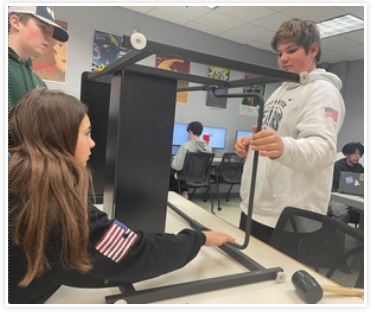Welcome to Sino Bearings web
24x7 HOTLINE:+86-28-81454188

 NEWS
NEWS
There is a problem at Brewster High School that Shanon Riley’s Project Lead the Way Design Engineering students are solving. Seven newly purchased desks with swinging foot rests have a design flaw: the bearings are too small, and the metal footrests are falling off.
“I’ll just be happy when these things stop crashing to the floor, “ said Jen Walsh Wood, the social studies teacher who approached Riley about the problem.
The class, which combines art and engineering, introduces students to the engineering profession, common approaches to solving engineering problems, and the engineering design process. Students work on structured activities and open-ended projects that require planning, documentation, communication, and other professional skills, along with a focus on aesthetics and design.
The problem with the desks has required students to plan, communicate and problem solve.
“The connectors or bearings for the footbars are too short, and they keep falling out, so we had to design our own, “ said Cole Wilson. “As an extra precaution, we also decided to make the hole for the connectors smaller.”
Set out on three tables, a desk was turned over and students worked with mallets and screwdrivers to take out the original connectors and replace them with their new and improved versions.
Neena Cahill used a flathead screwdriver to pry off one of the flawed black plastic connectors.
“The original piece wasn’t long enough, so we created a new one, using Fusion 360 software and the 3D printer,” said Ryan Gambardella.
“First, we measured the circumference of the hole using a dial caliper and created a new cylinder. However, our first bearings were too big for the holes, so we had to re-do it,” said Cole Wilson.
“It took 11 hours in the 3D printer to make the bearings,” said Neena Cahill. “Once we got the measurements right, some of the bearings still didn’t come out right. The printer isn’t always perfect, and even though the digital design was right, some of the bearings came out with small pieces on the inside, so we took a screwdriver and mallet and pried them out.”
“It was a good lesson in realizing that even when your design is perfect, it doesn’t always come out perfect,” said Riley. “I was really impressed with the students’ problem solving after the first attempts and the printer issues.”
After Neena pried out the flawed component, Ryan used a mallet to pound in the new and improved piece–a small white, plastic cylinder. After popping the metal footrest back into place and giving it a swing, the students were thrilled to see that their design worked.
By the end of the class, two of the seven desks had been fixed. Jake McCarthy and Zachary Beal carried one of the new and improved desks up two flights of stairs to the social studies classroom.
To Riley’s delight, the repair service included free delivery.